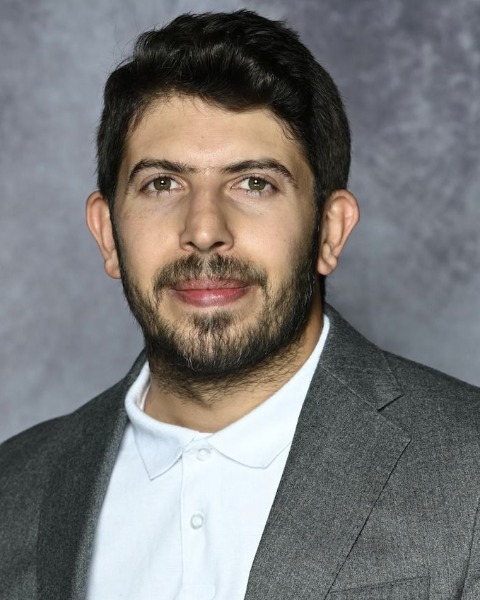Physiologically Based Pharmacokinetics
(T-037) Investigating tissue distribution of curcumin using Physiologically-based pharmacokinetic (PBPK) approach
Tuesday, October 21, 2025
7:00 AM - 1:45 PM MDT
Location: Colorado A
Pochung Chou – Pharmaceutical Sciences – Rutgers - The State University of New Jersey; Parv Dave – Pharmaceutical Sciences – Rutgers - The State University of New Jersey; Ah-Ng Kong – Pharmaceutical Sciences – Rutgers - The State University of New Jersey; Yuxin Pan – Pharmaceutical Sciences – Rutgers - The State University of New Jersey; Komal Patel – Pharmaceutical Sciences – Rutgers - The State University of New Jersey; Md. Shahid Sarwar – Pharmaceutical Sciences – Rutgers - The State University of New Jersey; Ahmad Shannar – Pharmaceutical Sciences – Rutgers - The State University of New Jersey; Jiawei Xu – Pharmaceutical Sciences – Rutgers - The State University of New Jersey

Ahmad Shannar, PhD, MA, PharmD
Ph.D Candidate
Rutgers - The State University of New Jersey, United States
Author(s)
Disclosure(s):
Ahmad Shannar: No financial relationships to disclose
Objectives: Curcumin, a bioactive compound with promising anti-inflammatory and antioxidant effects, exhibits complex pharmacokinetics due to low oral bioavailability, rapid metabolism, and extensive tissue distribution [1,2]. Understanding the in vivo disposition of curcumin is critical for optimizing therapeutic strategies and formulation design [3]. The objective of this analysis was to develop a physiologically-based pharmacokinetic (PBPK) model to characterize the plasma and major organs pharmacokinetics of curcumin in rats.
Methods: Time-course concentration data for curcumin in plasma and body organs following intravenous administration in rats were analyzed using HPLC and used to develop the PBPK model. A top-down modeling approach was employed using NONMEM® 7.5. Physiologically informed structural parameters such as organs’ blood flow and volumes were fixed based on literature values, while tissue partitioning and clearance parameters were estimated. Homogeneous organ distribution with First-order linear kinetics was assumed for distribution and elimination. Model performance was evaluated using goodness-of-fit plots, prediction-corrected visual predictive checks (pcVPCs), and nonparametric bootstrap diagnostics.
Results: The PBPK model adequately captured the observed plasma and organs concentration–time profiles of curcumin. The model suggested rapid initial organ uptake followed by redistribution to peripheral tissues, consistent with curcumin's known pharmacokinetic profile. Sensitivity analyses indicated that hepatic clearance and tissue partitioning were major drivers of systemic exposure.
Conclusions: This PBPK model provides a mechanistic framework to quantify curcumin distribution in plasma and major body organs using a simplified but physiologically relevant structure. The model enables simulation of tissue exposures under different dosing regimens routs of administrations and could be extended to include metabolite kinetics or adapted for other species, including humans. This approach supports translational modeling of natural products with complex tissue disposition and may inform future formulation strategies and preclinical study design.
Citations: [1] Shannar A, Chou PJ, Peter R, Dave PD, Patel K, Pan Y, Xu J, Sarwar MS, Kong AN. Pharmacodynamics (PD), Pharmacokinetics (PK) and PK-PD Modeling of NRF2 Activating Dietary Phytochemicals in Cancer Prevention and in Health. Curr Pharmacol Rep. 2025;11(1):6. doi: 10.1007/s40495-024-00388-6. Epub 2024 Dec 5. PMID: 39649473; PMCID: PMC11618211.
[2] Dei Cas M, Ghidoni R. Dietary Curcumin: Correlation between Bioavailability and Health Potential. Nutrients. 2019 Sep 8;11(9):2147. doi: 10.3390/nu11092147. PMID: 31500361; PMCID: PMC6770259.
[3] Tabanelli R, Brogi S, Calderone V. Improving Curcumin Bioavailability: Current Strategies and Future Perspectives. Pharmaceutics. 2021 Oct 17;13(10):1715. doi: 10.3390/pharmaceutics13101715. PMID: 34684008; PMCID: PMC8540263.
Keywords: Curcumin, PBPK, tissue distribution, NONMEM, pharmacokinetics
